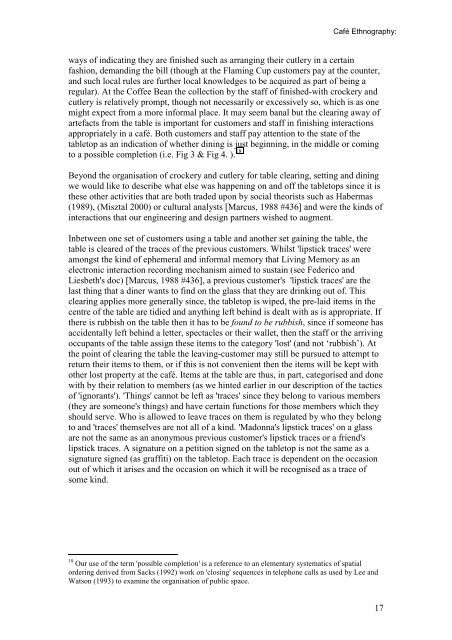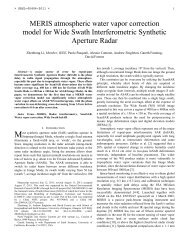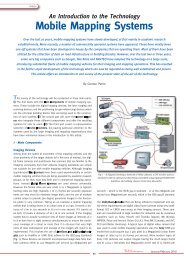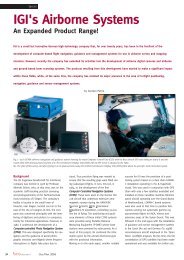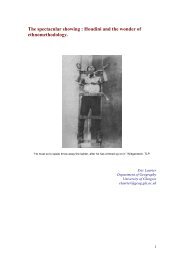Café Ethnography : the uses of tables and chairs
Café Ethnography : the uses of tables and chairs
Café Ethnography : the uses of tables and chairs
You also want an ePaper? Increase the reach of your titles
YUMPU automatically turns print PDFs into web optimized ePapers that Google loves.
<strong>Café</strong> <strong>Ethnography</strong>:<br />
ways <strong>of</strong> indicating <strong>the</strong>y are finished such as arranging <strong>the</strong>ir cutlery in a certain<br />
fashion, dem<strong>and</strong>ing <strong>the</strong> bill (though at <strong>the</strong> Flaming Cup customers pay at <strong>the</strong> counter,<br />
<strong>and</strong> such local rules are fur<strong>the</strong>r local knowledges to be acquired as part <strong>of</strong> being a<br />
regular). At <strong>the</strong> C<strong>of</strong>fee Bean <strong>the</strong> collection by <strong>the</strong> staff <strong>of</strong> finished-with crockery <strong>and</strong><br />
cutlery is relatively prompt, though not necessarily or excessively so, which is as one<br />
might expect from a more informal place. It may seem banal but <strong>the</strong> clearing away <strong>of</strong><br />
artefacts from <strong>the</strong> table is important for customers <strong>and</strong> staff in finishing interactions<br />
appropriately in a café. Both customers <strong>and</strong> staff pay attention to <strong>the</strong> state <strong>of</strong> <strong>the</strong><br />
tabletop as an indication <strong>of</strong> whe<strong>the</strong>r dining is just beginning, in <strong>the</strong> middle or coming<br />
to a possible completion (i.e. Fig 3 & Fig 4. ). 18<br />
Beyond <strong>the</strong> organisation <strong>of</strong> crockery <strong>and</strong> cutlery for table clearing, setting <strong>and</strong> dining<br />
we would like to describe what else was happening on <strong>and</strong> <strong>of</strong>f <strong>the</strong> tabletops since it is<br />
<strong>the</strong>se o<strong>the</strong>r activities that are both traded upon by social <strong>the</strong>orists such as Habermas<br />
(1989), (Misztal 2000) or cultural analysts [Marcus, 1988 #436] <strong>and</strong> were <strong>the</strong> kinds <strong>of</strong><br />
interactions that our engineering <strong>and</strong> design partners wished to augment.<br />
Inbetween one set <strong>of</strong> customers using a table <strong>and</strong> ano<strong>the</strong>r set gaining <strong>the</strong> table, <strong>the</strong><br />
table is cleared <strong>of</strong> <strong>the</strong> traces <strong>of</strong> <strong>the</strong> previous customers. Whilst 'lipstick traces' were<br />
amongst <strong>the</strong> kind <strong>of</strong> ephemeral <strong>and</strong> informal memory that Living Memory as an<br />
electronic interaction recording mechanism aimed to sustain (see Federico <strong>and</strong><br />
Liesbeth's doc) [Marcus, 1988 #436], a previous customer's 'lipstick traces' are <strong>the</strong><br />
last thing that a diner wants to find on <strong>the</strong> glass that <strong>the</strong>y are drinking out <strong>of</strong>. This<br />
clearing applies more generally since, <strong>the</strong> tabletop is wiped, <strong>the</strong> pre-laid items in <strong>the</strong><br />
centre <strong>of</strong> <strong>the</strong> table are tidied <strong>and</strong> anything left behind is dealt with as is appropriate. If<br />
<strong>the</strong>re is rubbish on <strong>the</strong> table <strong>the</strong>n it has to be found to be rubbish, since if someone has<br />
accidentally left behind a letter, spectacles or <strong>the</strong>ir wallet, <strong>the</strong>n <strong>the</strong> staff or <strong>the</strong> arriving<br />
occupants <strong>of</strong> <strong>the</strong> table assign <strong>the</strong>se items to <strong>the</strong> category 'lost' (<strong>and</strong> not ‘rubbish’). At<br />
<strong>the</strong> point <strong>of</strong> clearing <strong>the</strong> table <strong>the</strong> leaving-customer may still be pursued to attempt to<br />
return <strong>the</strong>ir items to <strong>the</strong>m, or if this is not convenient <strong>the</strong>n <strong>the</strong> items will be kept with<br />
o<strong>the</strong>r lost property at <strong>the</strong> café. Items at <strong>the</strong> table are thus, in part, categorised <strong>and</strong> done<br />
with by <strong>the</strong>ir relation to members (as we hinted earlier in our description <strong>of</strong> <strong>the</strong> tactics<br />
<strong>of</strong> 'ignorants'). 'Things' cannot be left as 'traces' since <strong>the</strong>y belong to various members<br />
(<strong>the</strong>y are someone's things) <strong>and</strong> have certain functions for those members which <strong>the</strong>y<br />
should serve. Who is allowed to leave traces on <strong>the</strong>m is regulated by who <strong>the</strong>y belong<br />
to <strong>and</strong> 'traces' <strong>the</strong>mselves are not all <strong>of</strong> a kind. 'Madonna's lipstick traces' on a glass<br />
are not <strong>the</strong> same as an anonymous previous customer's lipstick traces or a friend's<br />
lipstick traces. A signature on a petition signed on <strong>the</strong> tabletop is not <strong>the</strong> same as a<br />
signature signed (as graffiti) on <strong>the</strong> tabletop. Each trace is dependent on <strong>the</strong> occasion<br />
out <strong>of</strong> which it arises <strong>and</strong> <strong>the</strong> occasion on which it will be recognised as a trace <strong>of</strong><br />
some kind.<br />
18 Our use <strong>of</strong> <strong>the</strong> term 'possible completion' is a reference to an elementary systematics <strong>of</strong> spatial<br />
ordering derived from Sacks (1992) work on 'closing' sequences in telephone calls as used by Lee <strong>and</strong><br />
Watson (1993) to examine <strong>the</strong> organisation <strong>of</strong> public space.<br />
17


